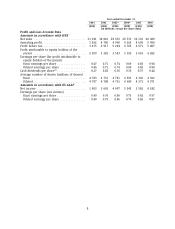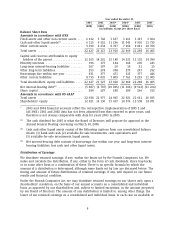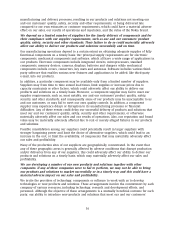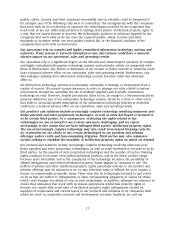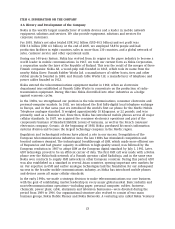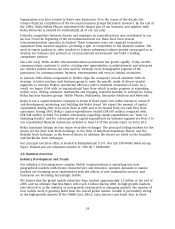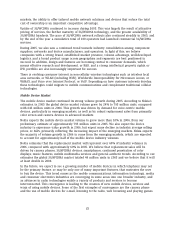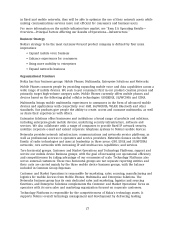Nokia 2005 Annual Report Download - page 20
Download and view the complete annual report
Please find page 20 of the 2005 Nokia annual report below. You can navigate through the pages in the report by either clicking on the pages listed below, or by using the keyword search tool below to find specific information within the annual report.customers may face claims of infringement in connection with our customers’ use of our products
and solutions.
In many aspects, the business models for mobile services have not yet been established. The lack
of availability of licenses for copyrighted content, delayed negotiations, or restrictive copyright
licensing terms may have an adverse effect on the cost or timing of content related services by us,
operators or third party service providers, and may also indirectly affect the sales of our mobile
devices.
Since all technology standards, including those used and relied on by us, include some intellectual
property rights, we cannot fully avoid risks of a claim for infringement of such rights due to our
reliance on such standards. We believe that the number of third parties declaring their intellectual
property to be relevant to these standards, for example, those standards related to so-called 3G
mobile communication technologies, including 3GPP and 3GPP2, as well as other advanced mobile
communications standards, is increasing, which may increase the likelihood that we will be
subject to such claims in the future. While we believe that any such intellectual property rights
declared and found to be essential to a given standard carry with them an obligation to be
licensed on fair, reasonable and non-discriminatory terms, not all intellectual property owners
agree on the meaning of that obligation and thus costly and time-consuming litigation over such
issues may result in the future.
From time to time, some existing patent licenses may expire, may become partially paid-up, or
otherwise may become subject to renegotiation. The inability to renew or finalize such
arrangements with acceptable commercial terms may result in costly and time-consuming
litigation, and any adverse result in any such litigation may lead to restrictions on our ability to
sell certain products or solutions, and could result in payments that potentially would have a
material adverse impact on our operating results.
Any restrictions on our ability to sell our products and solutions due to expected or alleged
infringements of third party intellectual property rights and any intellectual property rights
claims, regardless of merit, could result in material losses of profits, costly litigation, the payment
of damages and other compensation, the diversion of the attention of our personnel, product
shipment delays or the need for us to develop non-infringing technology or to enter into royalty
or licensing agreements. If we were unable to develop non-infringing technology, or if royalty or
licensing agreements were not available on commercially acceptable terms, we could be precluded
from making and selling the affected products and solutions. As new features are added to our
products and solutions, we may need to acquire further licenses, including from new and
sometimes unidentified owners of intellectual property. The cumulative costs of obtaining any
necessary licenses are difficult to predict and may over time have a negative effect on our
operating results.
In addition, despite the steps that we have taken to protect our intellectual property rights, we
cannot be certain that any rights or pending applications will be granted or that the rights
granted in connection with any future patents or other intellectual property rights will be
sufficiently broad to protect our technology. Any patents or other intellectual property rights that
are granted to us may be challenged, invalidated or circumvented, and any right granted under
our patents may not provide competitive advantages for Nokia. Other companies may commence
actions seeking to establish the invalidity of our intellectual property, for example, patent rights.
In the event that one or more of our patents are challenged, a court may invalidate the patent or
determine that the patent is not enforceable, which could harm our competitive position. If any of
our key patents are invalidated, or if the scope of the claims in any of these patents is limited by
a court decision, we could be prevented from using such patent as basis for product differentiation
or from licensing the invalidated or limited portion of our intellectual property rights. Even if such
18


